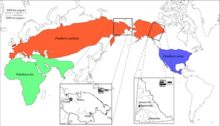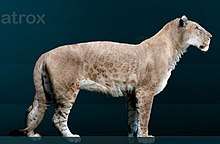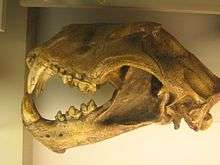American lion
The American lion (Panthera atrox), also known as the "North American lion", or "American cave lion", is an extinct pantherine cat that lived in North America during the Pleistocene epoch and the early Holocene epoch, about 340,000 to 11,000 years ago.[2][3][4] Its fossils have been excavated from Alaska to Mexico.[5][6] Genetic analysis has shown that the American lion and the Late Pleistocene Eurasian cave lion (Panthera spelaea) are sister lineages.[7] It was about 25% larger than the modern lion, making it one of the largest known felids.[8]
| American lion | |
|---|---|
 | |
| Skeleton from the La Brea tar pits at the George C. Page Museum | |
| Scientific classification | |
| Kingdom: | Animalia |
| Phylum: | Chordata |
| Class: | Mammalia |
| Order: | Carnivora |
| Suborder: | Feliformia |
| Family: | Felidae |
| Subfamily: | Pantherinae |
| Genus: | Panthera |
| Species: | †P. atrox |
| Binomial name | |
| †Panthera atrox | |
 | |
| The maximal range of cave lions - red indicates Panthera spelaea, blue Panthera atrox, and green Panthera leo leo/Panthera leo persica. | |
Taxonomy and evolution

The American lion was designated by American paleontologist Joseph Leidy as Felis atrox in 1853.[1] Hemmer proposed the trinomen Panthera leo atrox in 1974,[9] which was later supported by Kurten in 1985.[10]
The American lion was initially considered a distinct species of Pantherinae, and designated as Panthera atrox /ˈpænθərə ˈætrɒks/, which means "cruel" or "fearsome panther" in Latin. Some paleontologists accepted this view, but others considered it to be a type of lion closely related to the modern lion (Panthera leo) and its extinct relative, the Eurasian cave lion (Panthera leo spelaea or P. spelaea). It was later assigned as a subspecies of P. leo (P. leo atrox) rather than as a separate species.[3] Most recently, both spelaea and atrox have been treated as full species.[4]
Cladistic studies using morphological characteristics have been unable to resolve the phylogenetic position of the American lion. One study considered the American lion, along with the cave lion, to be most closely related to the tiger (Panthera tigris), citing a comparison of the skull; the braincase, in particular, appears to be especially similar to the braincase of a tiger.[11] Another study suggested that the American lion and the Eurasian cave lion were successive offshoots of a lineage leading to a leopard-extant lion clade.[12] A more recent study comparing the skull and jaw of the American lion with other pantherines concluded that it was not a lion but a distinct species. It was proposed that it arose from pantherines that migrated to North America during the mid-Pleistocene and gave rise to American lions and jaguars (Panthera onca).[3] Another study grouped the American lion with P. leo and P. tigris, and ascribed morphological similarities to P. onca to convergent evolution, rather than phylogenetic affinity.[13]
However, mitochondrial DNA sequence data from fossil remains suggests that the American lion (P. atrox) represents a sister lineage to the Eurasian cave lion (P. spelaea), and likely arose when an early cave lion population became isolated south of the North American continental ice sheet about 340,000 years ago.[7] The most recent common ancestor of the P. atrox lineage is estimated to have lived about 200,000 (118,000 to 346,000) years ago. This implies that it became genetically isolated from P. spelaea before the start of the Illinoian glaciation; a spelaea population is known to have been present in eastern Beringia by that time, where it persisted until at least 11,925 ± 70 years ago.[7] This separation was maintained during the interstadials of the Illinoian and following Wisconsin glaciations as well as during the Sangamonian interglacial between them. Boreal forests may have contributed to the separation during warmer intervals; alternatively, a reproductive barrier may have existed.[7]
The study also indicates that the modern lion is the closest living relative of P. atrox and P. spelaea.[7] The lineages leading to extant lions and atrox/spelaea were thought to have diverged about 1.9 million years ago,[4] before a whole genome-wide sequence of lions from Africa and Asia by Marc de Manuel et al. showed that the lineage of the cave lion diverged from that of the modern lion around 392,000 – 529,000 years ago.[14]
Description

The American lion is estimated to have measured 1.6 to 2.5 m (5 ft 3 in to 8 ft 2 in)[15] from the tip of the nose to the base of the tail and stood 1.2 m (3.9 ft) at the shoulder. Thus, it was smaller than its contemporary competitor, the giant short-faced bear, which was the largest carnivoran of North America at the time, and larger than the saber-toothed cat, Smilodon fatalis, which may have weighed up to 280 kg (620 lb).[16] In 2008, the American lion was estimated to weigh up to 420 kg (930 lb).[17][18] A study in 2009 showed an average weight of 256 kg (564 lb) for males and 351 kg (774 lb) for the largest specimen analyzed.[3] A study in 2012 estimated a range of 235–523 kg (518–1,153 pounds) for males and 175–365 kg (386–805 pounds) for females, which suggests that the lion was heavier than Smilodon.[19]

About 80 American lion individuals have been recovered from the La Brea Tar Pits in Los Angeles, so their morphology is well known.[20] Their features strongly resemble those of modern lions, but they were considerably larger, similar to P. spelaea and the Pleistocene Natodomeri lion of eastern Africa.[21]
Preserved skin remains found with skeletal material thought by its describers to be from the American lion in caves in the Argentine Patagonia indicate that the animal was reddish in color. Cave paintings from El Ceibo in the Santa Cruz Province of Argentina seem to confirm this, and reduce the possibility of confusion with fossil jaguars, as similar cave paintings accurately depict the jaguar as yellow in color.[22][23]
Distribution
The earliest lions known in the Americas south of Alaska are from the Sangamonian Stage – the last interglacial period – following which, the American lion spread from Alberta to Maryland, reaching as far south as Chiapas, Mexico.[24] It was generally not found in the same areas as the jaguar, which favored forests over open habitats.[15] It was absent from eastern Canada and the northeastern United States, perhaps due to the presence of dense boreal forests in the region.[25][26] The American lion was formerly believed to have colonized northwestern South America as part of the Great American Interchange.[27] However, the fossil remains found in the tar pits of Talara, Peru actually belong to an unusually large jaguar.[28][29][30] On the other hand, fossils of a large felid from late Pleistocene localities in southern Chile and Argentina traditionally identified as an extinct subspecies of jaguar, Panthera onca mesembrina, have been reported to be remains of the American lion.[23]
Habitat

The American lion inhabited savannas and grasslands like the modern lion.[8] In some areas of their range, American lions lived under cold climatic conditions. They probably used caves for shelter from the cold weather in those areas,[26][note 1] and might have lined their dens with grass or leaves, as the modern Siberian tiger does.[26]
The remains of American lions are not as abundant as those of other predators like Smilodon fatalis or dire wolves (Canis dirus) at the La Brea Tar Pits, which suggests that they were better at evading entrapment, possibly due to greater intelligence.[8] American lions likely preyed on deer, horses, camels, tapirs, American bison, mammoths, and other large ungulates (hoofed mammals).[3][26] Evidence for predation of bison by American lions is particularly strong as a mummified carcass nicknamed "Blue Babe" was discovered in Alaska with clear bite and claw marks from lions. Based on the largely intact nature of the carcass, it probably froze before the lions could devour it.[31] The American lion went extinct along with most of the Pleistocene megafauna during the Quaternary extinction event. The most recent fossil, from Edmonton, dates to 11,355 ± 55 years ago.[13] American lion bones have been found in the trash heaps of Paleolithic Native Americans, suggesting that human predation contributed to its extinction.[15][26]
A replica of the jaw of the first American lion specimen to be discovered can be seen in the hand of a statue of famous paleontologist Joseph Leidy, currently standing outside the Academy of Natural Sciences in Philadelphia.
See also
- Panthera leo fossilis
- List of largest carnivorans
- List of largest prehistoric carnivorans
- Megafauna
Notes
- This source confuses spelaea, which is the form found in Alaska and the Yukon, with atrox, the form known from Alberta southwards.
References
- Leidy, Joseph (1853). "Description of an Extinct Species of American Lion: Felis atrox". Transactions of the American Philosophical Society. 10: 319–322. doi:10.2307/1005282. JSTOR 1005282.
- Harington, C. R. (1969). "Pleistocene remains of the lion-like cat (Panthera atrox) from the Yukon Territory and northern Alaska". Canadian Journal of Earth Sciences. 6 (5): 1277–1288. Bibcode:1969CaJES...6.1277H. doi:10.1139/e69-127.
- Christiansen, P.; Harris, J. M. (2009). "Craniomandibular morphology and phylogenetic affinities of Panthera atrox: implications for the evolution and paleobiology of the lion lineage". Journal of Vertebrate Paleontology. 29 (3): 934–945. doi:10.1671/039.029.0314.
- Barnett, R.; Mendoza, M. L. Z.; Soares, A. E. R.; Ho, S. Y. W.; Zazula, G.; Yamaguchi, N.; Shapiro, B.; Kirillova, I. V.; Larson, G.; Gilbert, M. T. P. (2016). "Mitogenomics of the Extinct Cave Lion, Panthera spelaea (Goldfuss, 1810), Resolve its Position within the Panthera Cats". Open Quaternary. 2: 4. doi:10.5334/oq.24.
- Whitmore Jr, F.C.; Foster, H. L. (1967). "Panthera atrox (Mammalia: Felidae) from central Alaska". Journal of Paleontology. 61 (1): 247–251. JSTOR 1301922.
- Montellano-Ballesteros, M.; Carbot-Chanona, G. (2009). "Panthera leo atrox (Mammalia: Carnivora: Felidae) in Chiapas, Mexico". The Southwestern Naturalist. 54 (2): 217–223. doi:10.1894/CLG-20.1.
- Barnett, R.; Shapiro, B.; Barnes, I. A. N.; Ho, S. Y. W.; Burger, J.; Yamaguchi, N.; Higham, T. F. G.; Wheeler, H. T.; Rosendahl, W.; Sher, A. V.; Sotnikova, M.; Kuznetsova, T.; Baryshnikov, G. F.; Martin, L. D.; Harington, C. R.; Burns, J. A.; Cooper, A. (2009). "Phylogeography of lions (Panthera leo ssp.) reveals three distinct taxa and a late Pleistocene reduction in genetic diversity". Molecular Ecology. 18 (8): 1668–1677. doi:10.1111/j.1365-294X.2009.04134.x. PMID 19302360.
- Deméré, Tom. "SDNHM Fossil Field Guide: Panthera atrox". Archived from the original on 2009-06-25. Retrieved 2010-05-18.
- Hemmer, H. (1974). "Untersuchungen zur Stammesgeschichte der Pantherkatzen (Pantherinae), Teil III: Zur Artgeschichte des Löwen Panthera (Panthera) leo (Linnaeus 1758)". Veröffentlichungen der Zoologischen Staatssammlung München. 17: 167–280.
- Kurtén, B. (1985). "The Pleistocene lion of Beringia" (PDF). Annales Zoologici Fennici. 22 (1): 117–121. JSTOR 23734190.
- Groiss, J. Th. (1996). "Der Höhlentiger Panthera tigris spelaea (Goldfuss)". Neues Jahrbuch für Geologie und Paläontologie. 7: 399–414.
- Christiansen, Per (2008-08-27). "Phylogeny of the great cats (Felidae: Pantherinae), and the influence of fossil taxa and missing characters". Cladistics. 24 (6): 977–992. doi:10.1111/j.1096-0031.2008.00226.x.
- King, L. M.; Wallace, S. C. (2014-01-30). "Phylogenetics of Panthera, including Panthera atrox, based on craniodental characters". Historical Biology. 26 (6): 827 833. doi:10.1080/08912963.2013.861462.
- Manuel, M. d.; Ross, B.; Sandoval-Velasco, M.; Yamaguchi, N.; Vieira, F. G.; Mendoza, M. L. Z.; Liu, S.; Martin, M. D.; Sinding, M.-H. S.; Mak, S. S. T.; Carøe, C.; Liu, S.; Guo, C.; Zheng, J.; Zazula, G.; Baryshnikov, G.; Eizirik, E.; Koepfli, K.-P.; Johnson, W. E.; Antunes, A.; Sicheritz-Ponten, T.; Gopalakrishnan, S.; Larson, G.; Yang, H.; O’Brien, S. J.; Hansen, A. J.; Zhang, G.; Marques-Bonet, T.; Gilbert, M. T. P. (2020). "The evolutionary history of extinct and living lions". PNAS. 117: 10927–10934. doi:10.1073/pnas.1919423117.
- Anderson, Elaine (1984), "Who's Who in the Pleistocene: A Mammalian Bestiary", in Martin, P. S.; Klein, R. G. (eds.), Quaternary Extinctions, The University of Arizona Press, ISBN 978-0-8165-1100-6
- Christiansen, P.; Harris, J. M. (2005-10-18). "Body size of Smilodon (Mammalia: Felidae)". Journal of Morphology. 266 (3): 369–384. doi:10.1002/jmor.10384. PMID 16235255.
- Sorkin, B. (2008-04-10). "A biomechanical constraint on body mass in terrestrial mammalian predators". Lethaia. 41 (4): 333–347. doi:10.1111/j.1502-3931.2007.00091.x.
- Merriam, J. C. & Stock, C. 1932: The Felidae of Rancho La Brea. Carnegie Institution of Washington Publications 442, 1–231.
- DeSantis, L. R.; Schubert, B. W.; Scott, J. R.; Ungar, P. S. (2012). "Implications of diet for the extinction of saber-toothed cats and American lions". PLoS ONE. 7 (12): e52453. Bibcode:2012PLoSO...752453D. doi:10.1371/journal.pone.0052453. PMC 3530457. PMID 23300674.
- "About Rancho La Brea Mammals". Natural History Museum of Los Angeles County. 2012-08-06. Archived from the original on 2017-10-28. Retrieved 2017-10-28.
- Manthi, F.K.; Brown, F.H.; Plavcan, M.J.; Werdelin, L. (2017). "Gigantic lion, Panthera leo, from the Pleistocene of Natodomeri, eastern Africa". Journal of Paleontology. 92 (2): 305–312. doi:10.1017/jpa.2017.68.
- "Revelan que el León Americano Habitó la Patagonia" [They Reveal that the American Lion Inhabited Patagonia]. Todo Ciencia (in Spanish).
- Chimento, N. R.; Agnolin, F. L. (2017). "The fossil American lion (Panthera atrox) in South America: Palaeobiogeographical implications". Comptes Rendus Palevol. 16 (8): 850–864. doi:10.1016/j.crpv.2017.06.009.
- Marisol Montellano, Ballesteros; Carbot-Chanona, Gerardo (2009). "Panthera leo atrox (Mammalia: Carnivora: Felidae) in Chiapas, Mexico". The Southwestern Naturalist. 54 (2): 217–222. doi:10.1894/clg-20.1.
- "Panthera leo atrox". Paleobiology Database. Retrieved 2012-03-11.
- Harrington, C. R. (March 1996). "American Lion" (PDF). Yukon Beringia Interpretive Centre. Archived from the original (PDF) on 2017-10-30. Retrieved 2017-10-30.
- Kurtén, B.; Anderson, E. (1980). Pleistocene Mammals of North America. Columbia University Press. ISBN 978-0231037334. OCLC 759120597.
- Seymour, Kevin L. (1983). The Felinae (Mammalia: Felidae) from the Late Pleistocene tar seeps at Talara, Peru, with a critical examination of the fossil and recent felines of North and South America (MSc thesis). University of Toronto.
- Seymour, Kevin L. (2015). "Perusing Talara: Overview of the Late Pleistocene fossils from the tar seeps of Peru" (PDF). Science Series. 42: 97–109. Archived from the original (PDF) on 2018-10-01. Retrieved 2015-12-23.
- Yamaguchi, N.; Cooper, A.; Werdelin, L.; MacDonald, D. W. (2004). "Evolution of the mane and group-living in the lion (Panthera leo): A review". Journal of Zoology. 263 (4): 329. doi:10.1017/S0952836904005242.
- Turner, Alan; Anton, Mauricio (1997). The Big Cats and Their Fossil Relatives.
| Wikispecies has information related to Panthera leo atrox |
| Wikimedia Commons has media related to American lion. |